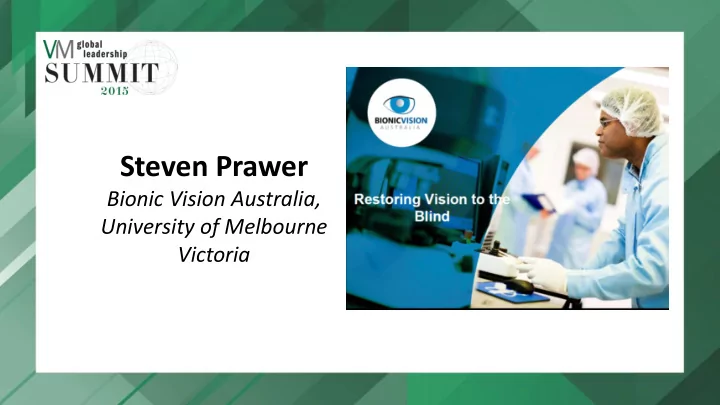

Steven Prawer Bionic Vision Australia, University of Melbourne Victoria
The Bionic Eye www.materials.unimelb.edu.au
The BVA team z Courtesy of Kumar Ganesan, 2010 10mm Courtesy of Gregg Suaning, 2010
BVA’s c ompetitive advantage The Team Arman Ahnood Nick Apollo Wei Tong Mathilde Escudie
Motivation: Eye Disease Retinitis Pigmentosa (RP) : Age Related Macular Degeneration (AMD) Leading cause of inherited blindness Major cause of vision loss in Western Countries 1.5 million people affected world wide 20-25 million people affected worldwide 25% of RP patients are legally blind Current cost (Australia) > $2B/year
Retinal prosthesis Epi-retinal Supra choroidal Sub-retinal Aim: stimulate the inner retina bypassing the damaged photoreceptors.
What it looks like Image courtesy of Bionics Institute
Di Ashworth Di NICTA Testing-HD 720p.mov BVA VNR FTA_MP4 360p (16x9).mp4
What do you see here? 16 Phosphenes
What do you see here? 64 Phosphenes
What do you see here? 1000 Phosphenes
What do you see here? Original Picture
Can you read this? 16 Phosphenes
Can you read this? 64 Phosphenes
Can you read this? 1000 Phosphenes
Choice of material for electrodes Mechanically durable Electrically conductive core and insulating body Biocompatible Chemically inert High thermal conductivity High charge injection capacity
Diamond: the material E XCEPTIONAL PROPERTIES INCLUDE : 4: D IAMOND AS A B IOMATERIAL 4: D IAMOND AS A B IOMATERIAL http://www.diamond-materials.com/ prod_heatspreaders_en.htm http://venda.uku.fi/research/biomaterials/Coatin gsBMTG.shtml D IAMOND UNIT CELL SAMANTHA LICHTER, ARNAM 2010 SAMANTHA LICHTER, ARNAM 2010
Diamond MPCVD - Polycrystalline diamond Recipe: H 2 , CH 4 for insulating PCD and H 2 , CH 4 , Ar, N2 for conducting UNCD Conductivity: B- or N-doping
Recommend
More recommend